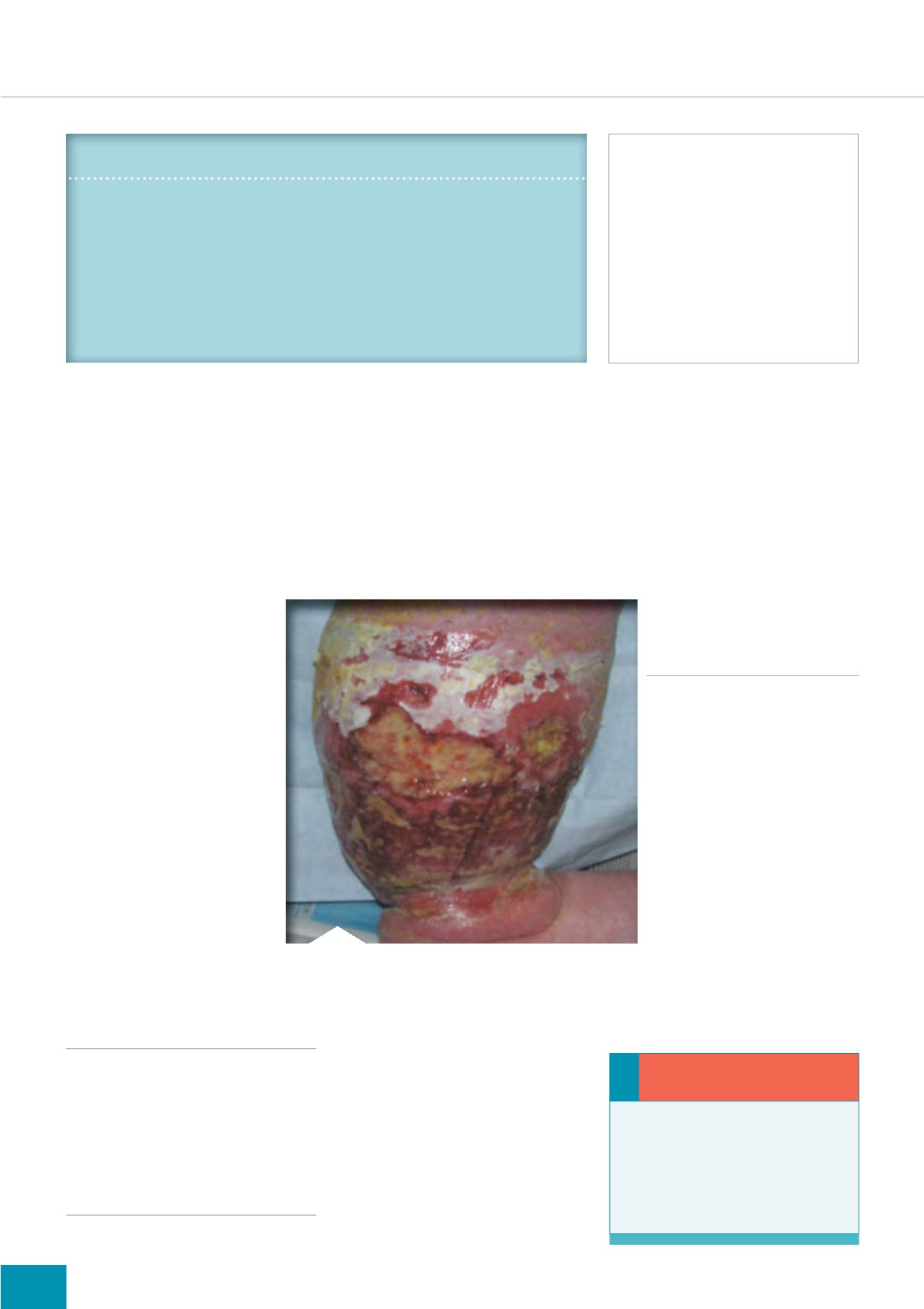
FOCUS ON ‘WET’ OR ‘LEAKY’ LEGS
i
34
SKIN CARE TODAY
2015,Vol 1, No 1
T
he terms‘wet’or‘leaky’
legs describe the pale
amber-coloured lymph
fluid that‘weeps’through breaks
in the skin of patients with
severely oedematous limbs,
when the lymphatic system
can no longer cope with the
increased fluid volume (Delon,
2012).This fluid increases the
risk of skin breakdown and
complications of infection
(Lymphoedema Framework,
2006), posing a considerable
challenge to clinicians.The
distress and discomfort it may
cause to patients should not
be underestimated, as it can
result in depression, isolation
and embarrassment (Rich and
McLachlan, 2003).
WHAT CAUSES
‘WET’ OR ‘LEAKY’ LEGS?
Chronic oedema, i.e. swelling that
has been present for at least three
months which does not resolve on
elevation, is the result of excess fluid
within interstitial spaces and tissues
that cannot be transported away
Identifying and managing
‘wet’ or ‘leaky’ legs
maceration (Lymphoedema
Framework, 2006).
ASSESSMENT
The key to effective treatment lies
in undertaking a comprehensive
holistic assessment to identify
underlying factors that may be
contributing to oedema, so that a
plan of care can be put in
place that will stop the disease
from progressing.
Clinicians undertaking
assessment should be skilled
and able to identify correctly
any underlying aetiologies in
order to facilitate an effective
management plan.
To assist in the assessment process,
it is helpful to use a systematic
Kirsty Mahoney, clinical nurse specialist, wound
healing, Cardiff andVale University Health Board
IN BRIEF
3HRSOH ZLWK FKURQLF RHGHPD O\PSKRHGHPD PD\ KDYH ¶ZHW OHDNLQJ
OHJV· L H O\PSKDWLF ÁXLG ¶ZHHSLQJ· WKURXJK WR WKH VNLQ·V VXUIDFH
7KLV FRPSOLFDWLRQ KDV D QHJDWLYH HIIHFW RQ TXDOLW\ RI OLIH DQG LV
FRVWO\ WR WKH KHDOWK VHUYLFH LQ WHUPV RI QXUVLQJ WLPH DQG WUHDWPHQWV
7UHDWPHQW LQFOXGHV D JRRG VNLQ FDUH UHJLPHQ DEVRUEHQW GUHVVLQJV
DQG FRPSUHVVLRQ WKHUDS\
(GXFDWLQJ DQG LQYROYLQJ SDWLHQWV LQ WKHLU RZQ VHOI FDUH LV FUXFLDO WR
PDLQWDLQ FRQFRUGDQFH ZLWK WUHDWPHQW
.
KEY WORDS:
&KURQLF RHGHPD
/\PSKRUUKHD
$VVHVVPHQW
&RPSUHVVLRQ WKHUDS\
6NLQ FDUH
3DWLHQW HGXFDWLRQ
DQG HQJDJHPHQW
Kirsty Mahoney
Figure 1.
Wet, leaking leg (lymphorrhea).
effectively (Moffatt, 2007; Hardy,
2010). Its causes can be complex
and due to a number of contributing
factors (
Table 1
; Keeley, 2009).
If left undetected and untreated,
symptoms will steadily worsen, with
the condition becoming irreversible
(Timmons and Bianchi, 2008).
Early detection and appropriate
management of oedema can reduce
complications such as skin changes,
cellulitis, leakage of fluid (‘wet’or
‘leaky’legs), odour, excoriation and
i
Practice point
$Q\ EUHDN LQ WKH VNLQ RI
RHGHPDWRXV OLPEV KRZHYHU
VPDOO H J FXWV DEUDVLRQV LQVHFW
ELWHV RU FUDFNV IURP EHLQJ WRR GU\
FDQ FDXVH ÁXLG WR OHDN RXW DQG
UHVXOW LQ ¶ZHW· RU ¶OHDN\· OHJV


